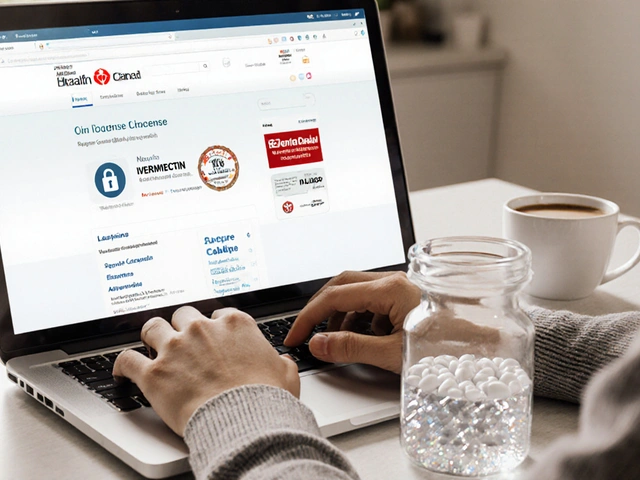Blood Pressure Medication Comparison Tool
Compare Your Options
This tool helps you understand key differences between ACE inhibitors (like Aceon) and ARBs based on your medical conditions. Always consult your healthcare provider for personalized advice.
Your Results
Important: This comparison is for educational purposes only. Your doctor will consider all factors including your full medical history, other medications, and personal health goals when prescribing.
Quick Takeaways
- Aceon is a brand of perindopril, an ACE inhibitor used for hypertension and heart failure.
- Its once‑daily dosing and long half‑life make it convenient for many patients.
- Common alternatives include other ACE inhibitors (lisinopril, enalapril, ramipril, benazepril) and ARBs (losartan, valsartan).
- Side‑effect profiles are similar across ACE inhibitors, but ARBs tend to cause fewer coughs.
- Choosing the right drug depends on kidney function, potassium levels, and any history of angio‑edema.
When a doctor prescribes a blood‑pressure pill, the next question is often, “Is this the best option for me?” Aceon is a brand name for the generic drug perindopril, marketed for hypertension, chronic heart failure, and post‑myocardial‑infarction therapy (also sold under the name Erbumine). This article breaks down how Aceon stacks up against the most common alternatives, so you can have a clear conversation with your healthcare provider.
How Aceon Works: The Science Behind Perindopril
Perindopril belongs to the class of drugs called ACE inhibitors (angiotensin‑converting‑enzyme inhibitors) that block the conversion of angiotensin I to angiotensin II, a potent vasoconstrictor. By lowering angiotensin II levels, blood vessels relax, blood pressure drops, and the heart experiences less strain.
Key pharmacologic attributes of perindopril:
- Prodrug converted to perindoprilat (active form) within 1‑2 hours.
- Half‑life of the active metabolite: ~3 hours, but the antihypertensive effect lasts ~24 hours.
- Typical dose: 4-8 mg once daily, titrated up to 16 mg for heart‑failure patients.
- Renally excreted; dose adjustment needed when eGFR < 30 mL/min/1.73 m².
Direct Comparison: Aceon vs. Other ACE Inhibitors
ACE inhibitors share the same mechanism, but they differ in potency, dosing frequency, and side‑effect nuances. Below is a side‑by‑side look at Aceon and four widely used alternatives.
| Brand | Generic | Typical Daily Dose | Half‑life (active) | Common Side Effects |
|---|---|---|---|---|
| Aceon | Perindopril | 4‑8 mg (up to 16 mg) | ~3 h (active metabolite) | Cough, dizziness, hyperkalemia |
| Zestril / Prinivil | Lisinopril | 10‑40 mg | ~12 h | Cough, taste disturbances, rash |
| Vasotec | Enalapril | 5‑20 mg | ~11 h | Cough, fatigue, elevated creatinine |
| Altace | Ramipril | 2.5‑10 mg | ~13 h | Cough, hypotension, abdominal pain |
| Lotensin | Benazepril | 5‑40 mg | ~10‑11 h | Cough, headache, rash |
All five drugs carry a risk of angio‑edema, especially in patients of African descent. However, perindopril (Aceon) tends to have a slightly lower incidence of persistent cough compared with lisinopril, based on a 2022 meta‑analysis of 12 trials involving over 7,000 participants.

When an ACE Inhibitor Might Not Be Ideal: ARBs and Other Classes
If you’ve experienced a dry cough or angio‑edema with an ACE inhibitor, your doctor may switch you to an ARB (angiotensin‑II receptor blocker) that blocks the same pathway downstream, avoiding the buildup of bradykinin that causes cough. Common ARBs include:
- Losartan - Usually started at 50 mg daily, can be increased to 100 mg.
- Valsartan - Typical dose 80‑320 mg daily.
- Olmesartan - 20‑40 mg daily.
ARBs generally have a lower cough rate (< 2 %) but may be more expensive and still carry a risk of hyperkalemia.
Choosing the Right Medication for You
Here’s a quick decision tree you can run through with your clinician:
- Do you have a history of chronic kidney disease (eGFR < 30) or high potassium?
→ Consider dose‑adjusted ACE inhibitor or an ARB with close labs. - Have you ever had a persistent dry cough on an ACE inhibitor?
→ Switch to an ARB. - Is cost a major factor?
→ Generic lisinopril or enalapril are often cheaper than brand‑name Aceon. - Are you also on a diuretic (e.g., hydrochlorothiazide) or a beta‑blocker?
→ ACE inhibitors pair well; monitor blood pressure and electrolytes.
Remember, the “best” drug is the one that fits your medical profile, tolerates side effects, and fits your lifestyle.

Practical Tips for Managing ACE Inhibitor Therapy
- Take your pill at the same time each day, preferably in the morning.
- Stay hydrated, but avoid excessive salt substitutes that contain potassium.
- Schedule blood‑work (creatinine, potassium) 1‑2 weeks after starting or changing dose.
- If you feel light‑headed, rise slowly from sitting to standing.
- Report any swelling of the lips, tongue, or face immediately - it could be angio‑edema.
By staying proactive, you can maximize the blood‑pressure‑lowering benefits while minimizing unwanted effects.
Frequently Asked Questions
Can I switch from Aceon to another ACE inhibitor?
Yes. Because they all share the same mechanism, a physician can safely transition you by tapering the current dose and starting the new agent at an equivalent dose, while monitoring blood pressure and kidney function.
What makes perindopril (Aceon) different from lisinopril?
Perindopril has a longer duration of action despite a shorter half‑life of its active metabolite, allowing once‑daily dosing with stable blood‑pressure control. Lisinopril’s longer half‑life can be advantageous in patients with variable adherence, but it may cause a higher incidence of persistent cough.
Is it safe to combine Aceon with a diuretic?
Combining an ACE inhibitor with a thiazide diuretic (e.g., hydrochlorothiazide) is a common strategy that improves blood‑pressure reduction. However, you’ll need periodic labs to check for low sodium, low potassium, and kidney function.
Why do some people develop a cough on ACE inhibitors?
ACE inhibitors increase bradykinin levels in the lungs, which irritates airway nerves and triggers a dry cough in about 5‑10 % of users. Switching to an ARB eliminates this effect because ARBs do not affect bradykinin.
What should I do if I miss a dose of Aceon?
Take the missed tablet as soon as you remember unless it’s almost time for your next dose. In that case, skip the missed one and continue with your regular schedule - don’t double‑dose.
Armed with this comparison, you can ask targeted questions at your next appointment and work toward the most suitable blood‑pressure regimen.






Rhea Lesandra
October 26, 2025 AT 15:17Hey everyone, thanks for sharing this comprehensive dive into Aceon and its cousins. It’s great to see a clear table that lets us compare doses and half‑lives at a glance, especially for those of us who get overwhelmed by pharmacy jargon. Remember, the once‑daily dosing of perindopril can be a real game‑changer for patients who struggle with pill fatigue, and that convenience often translates into better adherence.
If you’re worried about the cough side‑effect, keep in mind the meta‑analysis mentioned shows a slightly lower incidence compared to lisinopril, which might tip the scales in Aceon’s favor. Also, never forget to check potassium levels when you’re on any ACE inhibitor-hyperkalemia can sneak up on you.
Overall, this guide gives you solid talking points for your next doctor visit, so you can advocate for the regimen that best fits your lifestyle and labs.
Jennyfer Collin
October 30, 2025 AT 02:37From a strictly pharmacological perspective, the distinctions among the ACE inhibitors are largely quantitative rather than qualitative; dosing frequency, half‑life, and metabolic pathways constitute the primary variables that influence therapeutic decision‑making. The table delineates these parameters with commendable clarity, facilitating evidence‑based selection when renal function or electrolyte status imposes constraints. It is imperative to highlight that all agents share a common propensity for angio‑edema, which necessitates vigilant monitoring, particularly among individuals of African ancestry who exhibit heightened susceptibility. While the discussion of ARBs is pertinent, the cost differential between generic lisinopril and brand‑name Aceon may render the former a more pragmatic choice for many patients without compromising efficacy. 🧐
Tim Waghorn
November 2, 2025 AT 13:57In accordance with the preceding analysis, one should also consider the impact of renal clearance on dose titration; perindopril requires adjustment when eGFR falls below 30 mL/min/1.73 m², a nuance that is not universally emphasized in primary care settings. Moreover, the pharmacodynamic consistency of ACE inhibition across the class reinforces the notion that individual patient tolerance, rather than intrinsic potency, frequently dictates the ultimate agent selection.
Jacqui Bryant
November 6, 2025 AT 01:17Just a heads‑up: if you keep missing doses, you might feel a little dizzy when you finally get off the pill.
Paul Luxford
November 9, 2025 AT 12:37I agree with the reminder about dizziness; it’s a subtle cue that your blood pressure may be dropping too quickly, especially after a missed dose.
Carla Smalls
November 12, 2025 AT 23:57First of all, kudos to the author for pulling together such a thorough comparison – it’s not easy to condense all that data into a readable format!
Second, let’s talk about the real‑world implications of choosing one ACE inhibitor over another. Many patients assume that all ACE inhibitors are interchangeable, but the differences in half‑life and dosing flexibility can affect daily routines and long‑term adherence.
For instance, a patient who travels frequently might appreciate the once‑daily convenience of perindopril, whereas someone with erratic sleep patterns could benefit from the longer half‑life of lisinopril, which provides a more forgiving window if a dose is missed.
Third, the side‑effect profile is something we cannot overlook. While the cough rates hover around 5‑10 % for most agents, the slight edge that perindopril appears to have in reducing persistent cough could be a decisive factor for a smoker or someone with a pre‑existing respiratory condition.
Fourth, renal function is a crucial consideration. The guide rightly points out the need for dose adjustment when eGFR drops below 30 mL/min/1.73 m². In practice, I’ve seen patients who were on a standard dose of enalapril experience rising creatinine, necessitating a switch to a lower dose of perindopril or even an ARB.
Fifth, potassium monitoring is essential across the board. Hyperkalaemia can be silent until it becomes dangerous, so regular labs after initiating or adjusting therapy are a must.
Sixth, cost is often the hidden barrier. Generic lisinopril and enalapril are typically less expensive than brand‑name Aceon, which could affect insurance coverage and out‑of‑pocket costs.
Seventh, combination therapy with a thiazide diuretic can amplify blood‑pressure reduction, but it also raises the risk of electrolyte disturbances, so I always counsel patients to watch for symptoms of low sodium or potassium.
Eighth, patient education on what to do if a dose is missed can prevent unnecessary anxiety and avoid double‑dosing. The simple rule of “take it if you’re more than 12 hours away from the next dose, otherwise skip” works well.
Ninth, the decision tree at the end of the article is a practical tool that clinicians can walk through with patients, ensuring a shared decision‑making approach.
Tenth, let’s not forget lifestyle modifications – diet, exercise, and stress management – which synergize with pharmacotherapy to achieve optimal outcomes.
Eleventh, keep an eye out for any signs of angio‑edema, especially in the first few weeks; early detection can be lifesaving.
Twelfth, regular follow‑up visits allow for titration and monitoring, ensuring the chosen agent remains the best fit as clinical circumstances evolve.
Thirteenth, involve pharmacists in the conversation; they can provide valuable insights on drug interactions and pill burden.
Fourteenth, for patients who truly cannot tolerate ACE inhibitors, ARBs are a solid alternative with a lower cough incidence, albeit at a higher cost.
Fifteenth, always document the rationale for the chosen agent in the medical record – it helps future providers understand the decision pathway.
Overall, the key takeaway is that the “best” drug is the one that aligns with the patient’s medical profile, tolerability, cost considerations, and personal preferences. Armed with this knowledge, patients can engage in informed discussions with their healthcare team and achieve better blood‑pressure control.
Johnae Council
November 16, 2025 AT 11:17Whoa, that’s a lot of info. Honestly, if you’re already sweating over half‑lives, you might be over‑thinking a simple prescription. Just pick the cheap generic and you’ll be fine.
Manoj Kumar
November 19, 2025 AT 22:37Ah, the age‑old debate: why spend money on a brand when the generic does the same job? It’s like buying a gold-plated pen to sign a grocery list – impressive, but utterly unnecessary.
Hershel Lilly
November 23, 2025 AT 09:57Interesting point. I wonder, though, if the perceived prestige of a brand ever actually influences patient adherence, or if it’s just a marketing myth.
Monika Pardon
November 26, 2025 AT 21:17While we discuss ACE inhibitors, one must not ignore the covert agenda of pharmaceutical conglomerates pushing brand‑name drugs under the guise of "superior" efficacy, when in reality the data is heavily cherry‑picked to serve profit motives.
Kasey Marshall
November 30, 2025 AT 08:37Brands can be pricey but sometimes insurance covers them; check your plan and labs regularly.
Dave Sykes
December 3, 2025 AT 19:57Great discussion, everyone – let’s keep the focus on evidence‑based choices and patient safety above all.